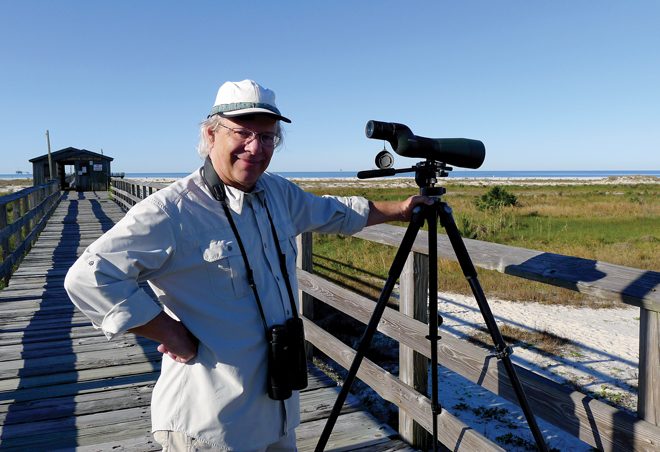
You never know what Barry Fleming might be up to — spinning mud into art, slapping a watermelon slice on a homemade biscuit, provoking and inspiring creativity in his art students, fueling his “live music problem” from backstage at Bonnaroo or scanning a Gulf Coast shoreline for marbled godwits. Fleming is a man of diverse talents, from gifted artist and arts educator to world-class birder, and many interests, from nature to culture to human nature. He’s also a firm believer that life’s experiences, especially those lived in the moment, are essential to the artistic process, and he’s a master at immersing himself in an experience and taking note of every detail. Those observational skills are invaluable to Fleming’s birding, art and teaching, but also to another of his talents – storytelling. When Fleming, who now lives in Opelika, bends your ear in his Tennessee twang, you never know where the story might be going, but you can bet it will be entertaining, enlightening and thought-provoking.
– Katie Jackson
You have a deep appreciation for, and knowledge of, plants, animals and the environment. When did that affinity for nature begin for you?
I was born in Laguna Beach, Calif., but I was transplanted to Tennessee at age 3, first to Inglewood and then to Hendersonville, which was a growing town at the time with lots of woods and creeks all around. I was a mischievous little kid and my parents pretty much let me go, so I got to be a serious fisher and also got into collecting snakes that I’d bring home and keep in my room, along with crawdads and mice and fish for the snakes to eat. My mom is not an animal person — she doesn’t even like a dog or a cat — but she let me have all those varmints, including the snakes that would escape sometimes in her house. It was a great way to grow up.
When did birds become part of that mix?
It was one bird on one day that did it. When I was in high school, I was fishing out in the headwaters of Drake’s Creek and up on a tree limb right above my head was a black-crowned night heron sitting there in full breeding plumage. I thought, “That’s something I need to know about. I bet you there’s a book that has this stuff in it.” So, I eased myself up to the Hendersonville public library, got me a bird book and started learning all the herons. Once I had those down, I thought I shouldn’t discriminate, so I started learning the other birds.
You admit to having a “live music problem,” an obsession with hearing really good music performed live, and you’re an expert on several musical genres. How did this music thing get started?
A lot of Nashville musicians lived in Hendersonville, so they were always around. I played ball against Conway Twitty, and Barbara Mandrell would show up at church and cry — I don’t know why she cried so much. We’d see Johnny Cash at the drugstore a lot, too. One of the original Oak Ridge Boys, who also sang backup for the Carol Lee Singers at the Grand Ole Opry, lived down the street from us and his son was one of my buddies. He’d take us with him when he sang at the Opry and we would hang out backstage and listen. We knew it wasn’t “cool” music, but we knew some of it was good and we’d show up at the junior high and tell people “Grandpa Jones is just as good as Jimi Hendrix.” They would say “NO WAY!”
Even when you were quite young, I understand you showed a real talent for drawing, but during grade school you were more interested in sports than art. What brought you back to art as a career?
When I got out of high school, I was working construction and didn’t know what I wanted to do, so I enrolled in the local community college. I took a drawing class there and during the final critique at the end of the semester the teacher asked us, “Why does someone become an artist?” Someone answered, “To make money.” “No,” she said. “For fortune and fame?” “No.” “To hang out with good looking people?” “No! You become an artist because you have to.” I was sitting there having a religious experience. I thought, “Yeah, I’ve got to do this.” So, I transferred to Western Kentucky University, where I got a BFA (in painting and ceramics, 1985), and then got my MFA (in painting, 1988) from the University of Tennessee.
During the three decades you taught art at Auburn University (1988-2017), you developed a reputation as an easy-going, supportive professor, but also one who challenged students to think and work harder. What was the most important lesson you wanted your students to learn?
I think my main job is to flip my students’ minds and teach them to be observant and remain open to new things. I think inspiration often comes from life experiences, so I tell them, “If you open yourself up to different kinds of art, or music or ideas, you’ll enrich your life and your art even more.”





